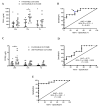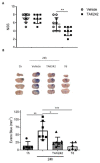Serum Amyloid A1/Toll-Like Receptor-4 Axis, an Important Link between Inflammation and Outcome of TBI Patients
- PMID: 34070533
- PMCID: PMC8227125
- DOI: 10.3390/biomedicines9060599
Serum Amyloid A1/Toll-Like Receptor-4 Axis, an Important Link between Inflammation and Outcome of TBI Patients
Abstract
Traumatic brain injury (TBI) is one of the leading causes of mortality and disability worldwide without any validated biomarker or set of biomarkers to help the diagnosis and evaluation of the evolution/prognosis of TBI patients. To achieve this aim, a deeper knowledge of the biochemical and pathophysiological processes triggered after the trauma is essential. Here, we identified the serum amyloid A1 protein-Toll-like receptor 4 (SAA1-TLR4) axis as an important link between inflammation and the outcome of TBI patients. Using serum and mRNA from white blood cells (WBC) of TBI patients, we found a positive correlation between serum SAA1 levels and injury severity, as well as with the 6-month outcome of TBI patients. SAA1 levels also correlate with the presence of TLR4 mRNA in WBC. In vitro, we found that SAA1 contributes to inflammation via TLR4 activation that releases inflammatory cytokines, which in turn increases SAA1 levels, establishing a positive proinflammatory loop. In vivo, post-TBI treatment with the TLR4-antagonist TAK242 reduces SAA1 levels, improves neurobehavioral outcome, and prevents blood-brain barrier disruption. Our data support further evaluation of (i) post-TBI treatment in the presence of TLR4 inhibition for limiting TBI-induced damage and (ii) SAA1-TLR4 as a biomarker of injury progression in TBI patients.
Keywords: biomarkers; immunomodulation; neuroinflammation; prognosis; traumatic brain injury.
Conflict of interest statement
Some results of the study have been included in a pending patent.
Figures







Similar articles
-
The Role of Neuroinflammation in Shaping Neuroplasticity and Recovery Outcomes Following Traumatic Brain Injury: A Systematic Review.Int J Mol Sci. 2024 Oct 31;25(21):11708. doi: 10.3390/ijms252111708. Int J Mol Sci. 2024. PMID: 39519259 Free PMC article.
-
Induction of pro-inflammatory genes by serum amyloid A1 in human amnion fibroblasts.Sci Rep. 2017 Apr 6;7(1):693. doi: 10.1038/s41598-017-00782-9. Sci Rep. 2017. PMID: 28386088 Free PMC article.
-
Serum amyloid A1 mediates myotube atrophy via Toll-like receptors.J Cachexia Sarcopenia Muscle. 2020 Feb;11(1):103-119. doi: 10.1002/jcsm.12491. Epub 2019 Aug 23. J Cachexia Sarcopenia Muscle. 2020. PMID: 31441598 Free PMC article.
-
Serum amyloid A1 secreted from UV-irradiated keratinocytes induces matrix metalloproteinase-1 in fibroblasts through toll-like receptor 4.Exp Dermatol. 2016 Jul;25(7):526-31. doi: 10.1111/exd.12979. Epub 2016 May 12. Exp Dermatol. 2016. PMID: 26900010
-
Metabolomics and Biomarker Discovery in Traumatic Brain Injury.J Neurotrauma. 2018 Aug 15;35(16):1831-1848. doi: 10.1089/neu.2017.5326. J Neurotrauma. 2018. PMID: 29587568 Review.
Cited by
-
The Role of Neuroinflammation in Shaping Neuroplasticity and Recovery Outcomes Following Traumatic Brain Injury: A Systematic Review.Int J Mol Sci. 2024 Oct 31;25(21):11708. doi: 10.3390/ijms252111708. Int J Mol Sci. 2024. PMID: 39519259 Free PMC article.
-
Inhibition of Extracellular Signal-Regulated Kinase Activity Improves Cognitive Function in Mice Subjected to Myocardial Infarction.Cardiovasc Toxicol. 2024 Aug;24(8):766-775. doi: 10.1007/s12012-024-09877-y. Epub 2024 Jun 8. Cardiovasc Toxicol. 2024. PMID: 38850470
-
Burn Injury Induces Proinflammatory Plasma Extracellular Vesicles That Associate with Length of Hospital Stay in Women: CRP and SAA1 as Potential Prognostic Indicators.Int J Mol Sci. 2021 Sep 18;22(18):10083. doi: 10.3390/ijms221810083. Int J Mol Sci. 2021. PMID: 34576246 Free PMC article.
-
Serum amyloid A and mitochondrial DNA in extracellular vesicles are novel markers for detecting traumatic brain injury in a mouse model.iScience. 2024 Jan 17;27(2):108932. doi: 10.1016/j.isci.2024.108932. eCollection 2024 Feb 16. iScience. 2024. PMID: 38323004 Free PMC article.
-
Toll-like receptor-mediated neuroinflammation: relevance for cognitive dysfunctions.Trends Pharmacol Sci. 2022 Sep;43(9):726-739. doi: 10.1016/j.tips.2022.05.004. Epub 2022 Jun 23. Trends Pharmacol Sci. 2022. PMID: 35753845 Free PMC article. Review.
References
-
- Jarrahi A., Braun M., Ahluwalia M., Gupta R.V., Wilson M., Munie S., Ahluwalia P., Vender J.R., Vale F.L., Dhandapani K.M., et al. Revisiting traumatic brain injury: From molecular mechanisms to therapeutic interventions. Biomedicines. 2020;8:389. doi: 10.3390/biomedicines8100389. - DOI - PMC - PubMed
Grants and funding
LinkOut - more resources
Full Text Sources
Miscellaneous

